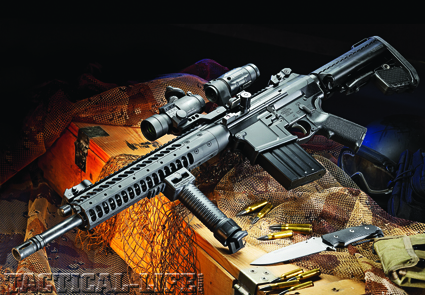The unique LWRCI’s Rapid Engagement Precision Rifle (REPR) is a full spectrum weapon system designed to put devastating 7.62mm on target in a variety of roles.
Although at times controversial amongst experts and administrators, the fact remains that many police agencies in this country have a need for a patrol rifle that is more powerful than the 5.56mm. It is often difficult for those working in urban areas to understand, but in many rural environments officers are under gunned, or just plain outgunned with a 5.56mm rifle. There are places in this country, especially out west, where a .30-06 is considered an intermediate cartridge, and a household may have a couple.
Quite a few folks had their first hunt with a .30-06 or .308 bolt action rifle. For many that is “just a hunting rifle” which is true, but bullets once fired do not care where they come from. A .30-06 heading your way — whether it was launched by an M1 Garand or Model 700 is irrelevant. When you pull up into the entrance of a ranch and start receiving fire from 300 yards away, the distinction becomes lost in the semantics. Returning fire with your AR15 in 5.56mm at this point may be a bit problematic. As easy as it is to shoot out on paper, how effective it can be becomes lost on the officer who has .30 caliber projectiles going through his car. At this point the term “mouse gun” has real meaning to the officer looking for cover. It is certainly somewhat of a tactical advantage to return fire with the same or larger caliber if possible.
Advertisement — Continue Reading Below
For many agencies the solution to this problem has been the government programs that provide surplus M14 rifles. Early on that was an option for many agencies in my home state of Utah. That program however is drying up a bit, and many agencies simply want a more modern firearm, or one that officers are most accustomed to. The most obvious solution is a 7.62x51mm rifle in the ubiquitous AR platform. Sounds simple, as the original design was actually provided in this caliber by Eugene Stoner in 1956. Many of these initial innovations were to be seen with the introduction of the AR15 / M16 rifle. As simple as it sounds in practice, providing a reliable rifle in this platform has proven far more problematic.
When introduced back into the market as the AR10 in the early 1990’s, the rifle was initially very popular. Having owned several and tested even more, the design with all its plusses and minuses is quite familiar. Initially they seemed to be rather hit and miss. Some were flawless and accurate, while others were flawed and more useful as a hammer. Most were reliable so long as the correct ammunition was used and the magazine worked well. The design did not lend itself well to either polymer tipped bullets or flat nosed bullets. The barrier round of the day was pretty flat and often would simply not cycle in this gun. The platform has seen its ups and downs and several other companies have created similar versions.
Knight’s SR25 is and has been fielded by our military for years. Although certainly a nice rifle, the price tag puts them well outside most agencies, and mere mortals, especially mere mortals with a badge. Every manufacturer has something a bit different about their rifle, and they are all advertized as 100% reliable. After years of testing and shooting firearms of every vintage, type, cost, and caliber, the term is a bit of a misnomer. To quote Clint Smith a few years back, “If they can spend billions of dollars on the space shuttle and it fails, your $2,500 rifle can fail as well!” In any case, testing seems to indicate most are pretty reliable today and many have addressed the primary issues with this platform.
Advertisement — Continue Reading Below
LWRC International is not new to the piston driven AR platform, they are in fact one of the early entries into this design. Almost since the introduction of the original gas impingement design people have wanted to meld the robust reliability of the AK47 gas pistol design and the ergonomics of the AR platform. The short piston designs of the LWRC weapons are one of the leaders in this arena and have proven very reliable in the 5.56mm and 6.8 SPC calibers. They are the choice of many who use these weapons in life and death conditions. As the market for a 7.62x51mm rifle has become stronger in this platform their introduction of a short piston design in this caliber has been long awaited. The gas piston design in general solves many of the issues surrounding this platform. Reliability with different types of ammunition whether as to bullet design or relative power is at the top of the list. There is also the issue of excess gas on short barrels, reliable extraction, and operation with a suppressor. The short piston design has addressed this in other calibers, so I was anxious to see if that was the case with the bigger bullets.
Gun Details
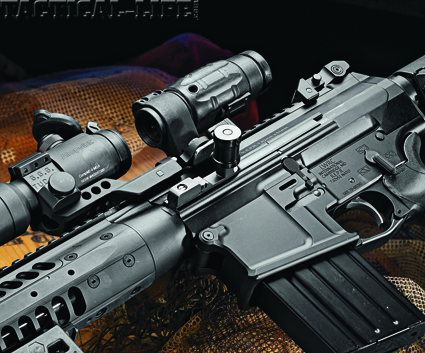
The self-regulating, short-stroke gas-piston operating system ensures unparalleled reliability, and a side-mounted charging handle allows the shooter to perform reloads without removing their eyes from the target.
Advertisement — Continue Reading Below
When first taking the REPR out of the box the attention to detail is evident. There are a lot of things on this rifle that address the concerns of actual operators. The first thing you will notice is the charging handle on the side. Many complaints have been about the standard charging handles on AR platformed rifles in this caliber and this addresses it nicely. The handle is large, easy to grasp, and smooth. There is no forward assist, something that will either be loved or hated. Another nice touch, although really a necessity with this design is the right side bolt catch/release. It not only makes lefties happy, it makes malfunction drills easier. An operator can easily pull the bolt to the rear and lock it back never having to come off target, not so easy with a standard system.
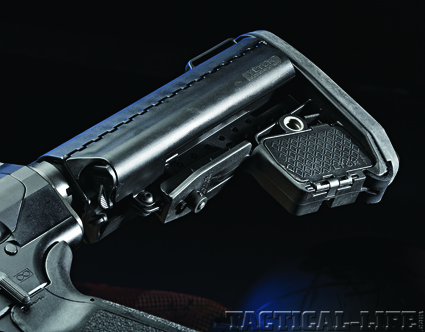
Magpul’s ACS is an excellent carbine stock and provides for stability and a good cheek weld.
Advertisement — Continue Reading Below
The sights are basically Troy Industries making them arguably the best out there. The stock is a 6-position Magpul ACS (Adaptable Carbine/Storage), perfect for a patrol rifle. The pistol grip is the full MIAD (Mission ADaptable) grip providing numerous options for the user. The handguard is a very well thought out design. It is smooth in construction with rails that can be attached as necessary. This allows the user to add as many or as few as needed, and in only that length required.
I was able to simply add one lower rail and attach my Grip Pod with a light leaving the rest of the rifle smooth. A really nice touch is the sling adapter included for attachment to the rail. It mounts to anywhere on the rail you see fit and accepts a quick release. Coupled with the attachment on the ACS you have a true quick connect sling and no need to hunt down another part.
The trigger is a Geissele, it is the trigger of my choice and sits in both of my guns today. It is reliable, crisp, and perfect for a duty rifle. The rifle comes with one 20-round magazine as well as the usual manuals. All an officer needs to do is add a sling, light, and a spare magazine and they are ready to put this rifle to work.
Advertisement — Continue Reading Below
Shooting Impressions
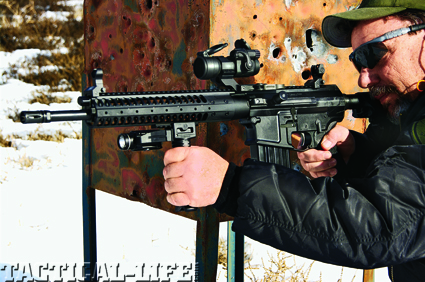
The 20-shot mag, ergonomic design, and gas system make the REPR an excellent choice for patrol use.
For the purposes of the test I added an Aimpoint CompM3 in a GG&G mount and a Grip Pod with Streamlight’s TLR1 attached. One of the first things noticed was the need to be aware of the side-charging handle and your scope mounts. Depending on your mount, be certain it does not interfere with your ability to grasp the charging handle. The scope and mount combination used for the test required me to move a bit forward for complete access.
Advertisement — Continue Reading Below
While I am on the topic of the bolt handle, a word of caution when you have the bolt locked to the rear. As a right-hander the right side bolt release is really convenient, but make certain your support hand does not interfere with the bolt handle going forward as it will prevent it going into battery. Some operators like to grasp the magazine well with their off-hand, if you do so and press the bolt release, depending on paw size, you will interfere with it. It is an operator issue, not a gun issue, but it is something to be aware of. The issues this design addresses far outweigh a change in operator habits. The magazine release is protected and the right side bolt release is situated such that accidental activation shouldn’t occur. As expected, the trigger is very clean and crisp, and at a weight appropriate to duty use. Once accustomed to the new features it was time to exercise my trigger finger.
Since this is really a patrol rifle — the shooting was appropriate to that task. Nothing over 100 yards, 95% of the shooting was done at 50 yards and not from a bench. All was from kneeling, off-hand, or prone in the dirt. Seven different ammunition types went through this weapon. They ranged from 147-grain to 175-grain in weight, and had polymer tips, flat noses, and typical OTM designs. Some were match grade, other were military surplus. Once the magazines were sorted out it all worked through this gun. I used the included magazine as well as several DPMS magazines and a couple of old KMC magazines I had left over from my SR25 of old. The magazine with the gun worked great, but two of the DPMS magazines were a bit finicky, as well as one of the SR25 magazines. In both cases the rounds would go over the top and not feed. After many rounds and careful diagnosis they would not seat quite as high as the others, and were looser. This is not new and not generally a gun issue, but a magazine issue and it has plagued designers of these systems for years. The magazine supplied worked flawlessly but if you use others do not assume they will work, nor assume it is the gun. Especially for duty use, make sure you sort that out first. But, once that was sorted out it kicked them out with authority and never missed a beat.
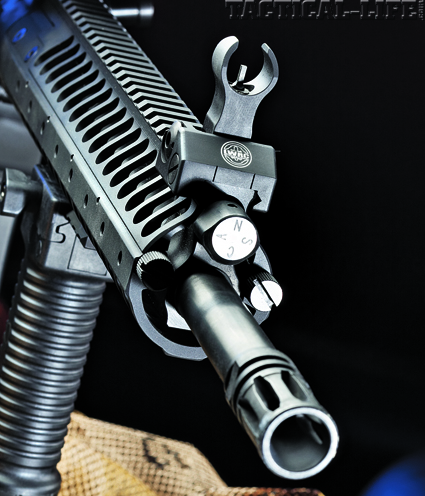
Advertisement — Continue Reading Below
The adjustable gas system allows for ammunition variance and suppressor use.
When it comes to accuracy this rifle really hit the mark. Although I did not test it like a DMR, it was very accurate. I used one target over the course of the day at all ranges and at the end of the day nothing was really outside a 6-inch circle and most was much tighter. Accuracy achieved with a red dot or iron sights, not optics. I have little doubt this rifle will put just about anything you feed it into an inch or so at 100 yards. It is more accurate than most of us that would get behind it, and more than appropriate for a patrol rifle, and with optics maybe even a close range DMR.
The ergonomics were superb, and the left-side charging handle is nice. Reloads are fast and there was never a need to unplug to perform reloads or malfunction drills. A real plus was no gas in the face and a very clean bolt after almost 500 rounds of various ammunition. All the pieces are there to make this rifle perfectly suited to the patrol rifle task.
Advertisement — Continue Reading Below
Final Notes
LWRCI has addressed most all of the issues that come with this platform in this caliber. Short of making their own magazine, which is simply not cost effective, everything else has been addressed. Fact is, anyone taking a rifle to work should make sure all their magazines work regardless of design. It has always been the weakness of magazine fed rifles and likely always will be. It is accurate, reliable with solid magazines, ergonomically sound, and easy to shoot. The left side charging handle worked well and it was pleasant to fire that much ammunition and not having to suck up a ton of expended gas. If you are looking at a patrol rifle in .30 caliber take a good hard look at the LWRCI REPR, you will not be disappointed.
